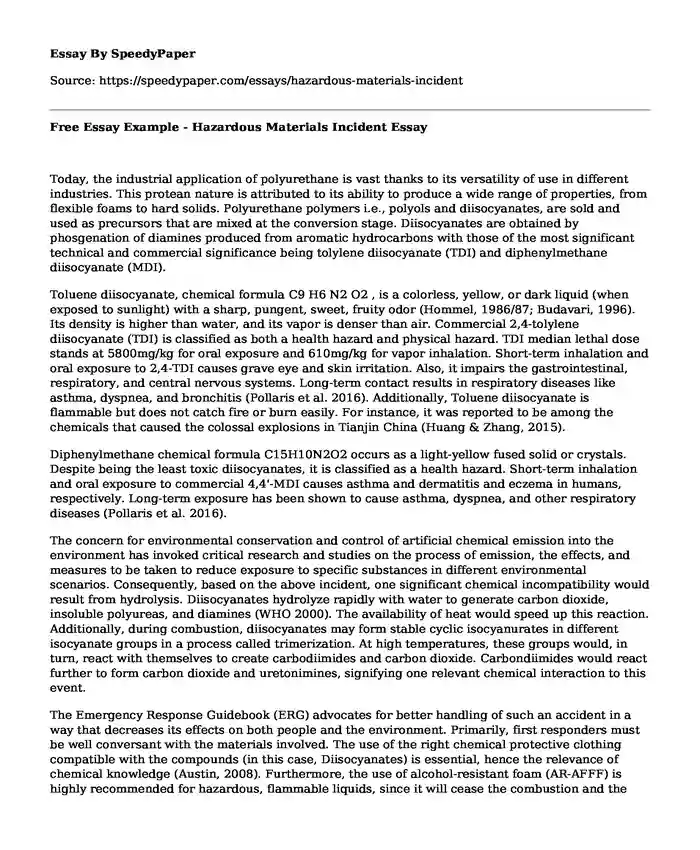
| Type of paper: | Essay |
| Categories: | Knowledge Engineering Chemistry |
| Pages: | 3 |
| Wordcount: | 721 words |
Today, the industrial application of polyurethane is vast thanks to its versatility of use in different industries. This protean nature is attributed to its ability to produce a wide range of properties, from flexible foams to hard solids. Polyurethane polymers i.e., polyols and diisocyanates, are sold and used as precursors that are mixed at the conversion stage. Diisocyanates are obtained by phosgenation of diamines produced from aromatic hydrocarbons with those of the most significant technical and commercial significance being tolylene diisocyanate (TDI) and diphenylmethane diisocyanate (MDI).
Toluene diisocyanate, chemical formula C9 H6 N2 O2 , is a colorless, yellow, or dark liquid (when exposed to sunlight) with a sharp, pungent, sweet, fruity odor (Hommel, 1986/87; Budavari, 1996). Its density is higher than water, and its vapor is denser than air. Commercial 2,4-tolylene diisocyanate (TDI) is classified as both a health hazard and physical hazard. TDI median lethal dose stands at 5800mg/kg for oral exposure and 610mg/kg for vapor inhalation. Short-term inhalation and oral exposure to 2,4-TDI causes grave eye and skin irritation. Also, it impairs the gastrointestinal, respiratory, and central nervous systems. Long-term contact results in respiratory diseases like asthma, dyspnea, and bronchitis (Pollaris et al. 2016). Additionally, Toluene diisocyanate is flammable but does not catch fire or burn easily. For instance, it was reported to be among the chemicals that caused the colossal explosions in Tianjin China (Huang & Zhang, 2015).
Diphenylmethane chemical formula C15H10N2O2 occurs as a light-yellow fused solid or crystals. Despite being the least toxic diisocyanates, it is classified as a health hazard. Short-term inhalation and oral exposure to commercial 4,4'-MDI causes asthma and dermatitis and eczema in humans, respectively. Long-term exposure has been shown to cause asthma, dyspnea, and other respiratory diseases (Pollaris et al. 2016).
The concern for environmental conservation and control of artificial chemical emission into the environment has invoked critical research and studies on the process of emission, the effects, and measures to be taken to reduce exposure to specific substances in different environmental scenarios. Consequently, based on the above incident, one significant chemical incompatibility would result from hydrolysis. Diisocyanates hydrolyze rapidly with water to generate carbon dioxide, insoluble polyureas, and diamines (WHO 2000). The availability of heat would speed up this reaction. Additionally, during combustion, diisocyanates may form stable cyclic isocyanurates in different isocyanate groups in a process called trimerization. At high temperatures, these groups would, in turn, react with themselves to create carbodiimides and carbon dioxide. Carbondiimides would react further to form carbon dioxide and uretonimines, signifying one relevant chemical interaction to this event.
The Emergency Response Guidebook (ERG) advocates for better handling of such an accident in a way that decreases its effects on both people and the environment. Primarily, first responders must be well conversant with the materials involved. The use of the right chemical protective clothing compatible with the compounds (in this case, Diisocyanates) is essential, hence the relevance of chemical knowledge (Austin, 2008). Furthermore, the use of alcohol-resistant foam (AR-AFFF) is highly recommended for hazardous, flammable liquids, since it will cease the combustion and the production of toxic gases. After the fire incident, appropriate steps need to be observed on how to dispose of TDI and MDI residues. Consultations should be made to both the fire department and the diisocyanate manufacturers. Additionally, proper residue tests must be done to neutralize and decontaminate the environment, and equipment and to establish proper disposal measures as per local regulations.
Conclusively, the formulation of corrective measures is necessary to avoid the reoccurrence of such incidents. The occurrence of fire incidents is dependent on three main factors, i.e., fuel (TDI), ignition source, and oxygen. Theoretically, the elimination of one factor inhibits others. The most operative control measure is at the design phase, where the leakage is minimized, airflow is controlled, and exposures are reduced. For instance, the use of pipeline transportation would work appropriately.
References
Austin, P. (2008). Emergency Response Guidebook (No. SAND2008-3495C). Sandia National Lab.(SNL-NM), Albuquerque, NM (United States). https://www.osti.gov/servlets/purl/1142963
Huang, P., & Zhang, J. (2015). Facts related to August 12, 2015 explosion accident in T ianjin, C hina. Process Safety Progress, 34(4), 313-314. https://aiche.onlinelibrary.wiley.com/doi/abs/10.1002/prs.11789
Pollaris, L., Devos, F., De Vooght, V., Seys, S., Nemery, B., Hoet, P. H., & Vanoirbeek, J. A. (2016). Toluene diisocyanate and methylene diphenyl diisocyanate: asthmatic response and cross-reactivity in a mouse model. Archives of toxicology, 90(7), 1709-1717. https://link.springer.com/article/10.1007/s00204-015-1606-6
Cite this page
Free Essay Example - Hazardous Materials Incident. (2023, Jul 11). Retrieved from https://speedypaper.net/essays/hazardous-materials-incident
Request Removal
If you are the original author of this essay and no longer wish to have it published on the SpeedyPaper website, please click below to request its removal:
- Essay Example: Pharmacy School Personal Statement
- Essay Example for Your Use: Urban Livability
- Free Essay Sample on Speech Communities
- Free Paper Sample: Threats to Validity Exercise
- Paper Example. Approaches to Modelling as a Form of Counseling Training
- Essay Example: Natural Language Processing in AI
- Analysis of My Experience - Essay Example
Popular categories




